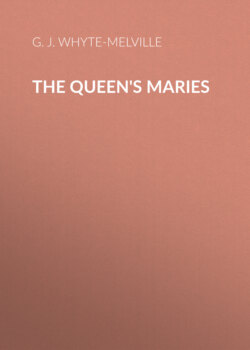Читать книгу The Queen's Maries - G. J. Whyte-Melville - Страница 5
На сайте Литреса книга снята с продажи.
Оглавление‘What need have we of beacon sheen
To warn us or to save,
With the star-bright eyes of our lovely Queen
Guiding us o’er the wave?
‘What need have we of a following tide?
What need of a smiling sky?
’Tis sunshine ever at Mary’s side,
And summer when she is by.
‘Her glances, like the day-god’s light,
On each and all are thrown;
Like him she shines, impartial, bright,
Unrivall’d, and alone.
‘Alone! alone! an ice-queen’s lot,
Though dazzling on a throne;
Ah! better to love in the lowliest cot
Than pine in a palace—alone!’
As he concluded, the singer approached Her Majesty with the information she had sent him to seek.
Softened by her sorrows, influenced by the time, the scene, the devotion of her follower, feeling now more than ever the value of such kind adherents, what could Mary do but reach him graciously the white hand that was not the least attractive of her peerless charms? And if Chastelâr pressed it to his lips with a fervour that partook more of the lover’s worship than the subject’s loyalty, what less was to be expected from an overwrought imagination, and a susceptible heart, thus brought in contact with the most fascinating woman of the age? And the Queen drew away her hand hurriedly, rather than unkindly, with a consciousness not wholly displeasing, and Mary Seton looked discreetly into the far distance, as though there was something unusually interesting in that dull expanse of sea. And Mary Hamilton, clasping both hands tightly to her heart, leaned her head against the bulwark, and said nothing; but rose, as if intensely relieved, when an increasing bustle on board the galley, and a general movement amongst its inmates, denoted some fresh alarm, and the necessity for increased watchfulness and exertion.
It was even so. Their consort, holding a parallel course at no great distance, had caught sight of the English cruisers, who, whatever might be their orders from ‘good Queen Bess,’ were as much mistrusted by d’Elbœuf in his command of the Scottish Queen’s little squadron, as by d’Amville who took her own galley under his especial charge. In those days the sea and land services were not so distinct as now.
Signals were exchanged between the two galleys to make all possible speed, and the slaves, grateful for Mary’s interposition on their behalf, laid to their oars with a will, in a manner that could never have been extorted from them by the lash. As there was but little wind, they soon increased their distance from the English men-of-war, who, however, came up with and captured one of the French ships containing the Earl of Eglinton and the Queen’s favourite saddle-horses. Mary herself, nevertheless, escaped their vigilance, and an increasing fog soon shrouded the little convoy from its pursuers.
Thus in darkness and danger, too ominous, alas! of her subsequent career, Mary Stuart sped on towards the coast of Scotland, leaving behind her the sunny plains of her beloved France, as she left behind her the bright days of her youth—days that she seemed instinctively to feel were never to dawn for her again through the storms and clouds that brooded over the destinies of her future kingdom.
